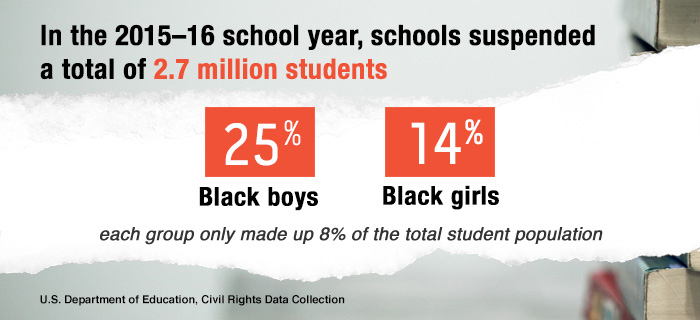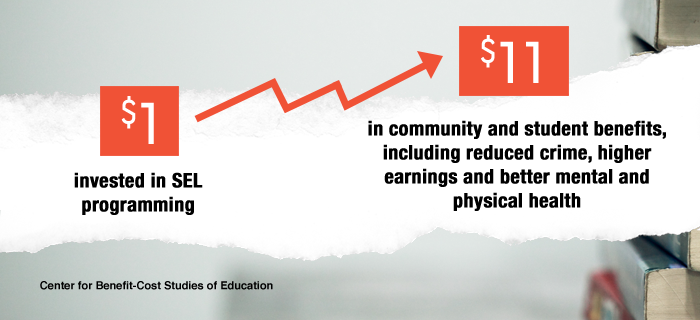Why It Matters

There is a large body of research illustrating the correlation between exclusionary discipline practices and an increased likelihood of not graduating from high school and involvement with the criminal justice system, as well as lower academic performance.
The “school-to-prison pipeline” refers to the trend of school discipline policies that have disproportionately affected certain student populations and contributed to their involvement in the criminal justice system. Research finds that disproportionality in school discipline rates “not explained by more frequent or more serious misbehavior” by students of color.
Students of color and students with disabilities are disproportionately suspended or expelled
Data on resource officers
During the 2017-18 school year, a higher percentage of schools with 1,000 or more students had at least one sworn law enforcement officer who routinely carried a firearm (79%) than schools with 500-999 students (52%), schools with 300-499 students (36 percent), and schools with less than 300 students (34%).
Social and emotional learning (SEL) is the process through which children and adults acquire and effectively apply the knowledge, attitudes, and skills necessary to understand and manage emotions, set and achieve positive goals, feel and show empathy for others, establish and maintain positive relationships, and make responsible decisions.
As educators know, and as research has shown, social and emotional learning is critical to student learning and success.
Students in SEL programs are more likely to attend school and receive better grades, and are less likely to have conduct problems.
A meta-analysis of studies on SEL program outcomes involving more than 300,000 K–8 students found positive impacts from the programs both in and out of school, across racial and ethnic backgrounds and geography, and regardless of student history of emotional or behavioral issues.
A 2015 analysis found that, on average, every dollar invested in SEL programming yields $11 in long-term benefits, including reduced juvenile crime, higher lifetime earnings, and better mental and physical health.
An analysis has shown that the academic performance of students exposed to SEL programs was an average of 13 percentage points higher than their non-SEL peers.
Conduct problems, emotional distress, and drug use were all significantly lower for students exposed to SEL programs, and development of social and emotional skills and positive attitudes toward self, others, and school was higher.
Research has shown that SEL can improve school climate and culture, which can in turn reduce chronic absenteeism.
Using SEL can contribute to numerous factors critical to student attendance, including engaging students in learning, getting them more excited about school, and reducing depression and stress.
Background
Research has found that restorative practices—inclusive and non-punitive ways to respond to conflict and build community—are successful in reducing suspensions. In particular, restorative practices reduced suspension rates for elementary students, Black students, female students, and students from low-income families. Teachers also reported that their school environments felt safer, rebutting critics who contend that reducing suspensions equates to a less safe classroom.
More recent research into the impacts of restorative practices on racial discipline have found positive results. A randomized controlled trial comparing outcome measures in 22 restorative justice schools to those in 22 control schools indicates that restorative justice implementation led to a reduction in the racial discipline gap between Black and White students.
A 2018 analysis of Los Angeles Unified School District’s discipline records following the implementation of restorative practices during the 2014-15 academic year demonstrates that suspension rates for misconduct dropped for all measured categories of students—Black, Latino, Asian, and White students; students with disabilities; English learner students; and students eligible for free or reduced-price lunch. The analysis also indicates that even though discipline gaps related to race and disability status persisted, those gaps narrowed considerably.
And teachers want to grow and develop their skills in restorative practices. A recent survey found that 35% of teachers want more professional development in alternative practices to punitive discipline. And research backs this, showing that schools that offered intensive training and follow-up for staff demonstrated positive results across a range of discipline outcomes. A study on restorative schools grants in Minnesota found that one elementary school experienced a 57% drop in discipline referrals, a 35% drop in average time of in-school suspensions, a 77% drop in out-of-school suspensions, and only one student was expelled during the one-year follow-up. Results from other schools in Minnesota that had strong training were similar (45% to 63% decrease in suspensions, for example).
Questions to Ask
Are there disparities in disciplinary treatment based on race, ethnicity, gender, or disability status?
Does your district’s school discipline code contain ambiguity that could contribute to disparities in the handling of discipline referrals?
Does your district have implicit bias training for school-based staff? Is it mandatory or optional?
Does your district have access to data that could be used to determine if there is any disproportionality in disciplinary actions?
Is data collected at the state, district, and school level?
Is the data disaggregated by race, ethnicity, gender, disability status, and first language?
Is the data disaggregated by type of discipline?
Is the data disaggregated by type of infraction and the number of school days missed?
Is the data disaggregated by grade level?
Is the annual, disaggregated data easily available to the public?
Are there alternatives in your schools to exclusionary and punitive discipline methods, such as restorative practices, trauma-informed practices, and positive behavioral supports and interventions?
If so, how are teachers and school personnel being trained to use these methods?
Does your district offer or require implicit bias training for teachers and school resource officers?
Who receives professional development in your school district on classroom management and conflict resolution?
Is the training culturally relevant? Is it mandatory? How frequently is it offered?
What services and opportunities are funded and provided in your district’s schools to support students’ social, health, and psychological needs?
Are there guidance counselors in every school in the district?
Do your schools have alternative educational settings for students who violate codes of conduct that meet the students’ academic, social, health, and psychological needs?
If your district authorizes charter schools, do the disciplinary policies apply equally to traditional district and charter schools?
What oversight methods are leveraged to ensure charter students are treated equitably with respect to discipline policies?
Related Issue Areas
Teacher racial diversity
Elementary school students are less likely to be subjected to exclusionary discipline when their race matches that of their teacher.
Professional development (teachers, school personnel)
Teachers and school personnel need resources and supports to be able to integrate alternative strategies into their instruction and work with students.
Mental health professionals in schools
School counselors are critical in preventing violence and keeping students safe.
Data (availability, transparency)
Publicly reported, disaggregated data is critical for stakeholders to understand how school discipline policies are impacting students.
Learn More
Breaking Schools’ Rules: A study from the CSG Justice Center and the Public Policy Research Institute at Texas A&M University of how school discipline is related to students’ success and juvenile justice involvement
Are We Closing the School Discipline Gap?: A report on the school discipline gap and policy recommendations
50-State Comparison: State Policies on School Discipline: A report by the Education Commission of the States
Find Your District Discipline Data: A searchable database through the Center for Civil Rights
Why It Matters

Social and emotional learning (SEL) is the process through which children and adults acquire and effectively apply the knowledge, attitudes, and skills necessary to understand and manage emotions, set and achieve positive goals, feel and show empathy for others, establish and maintain positive relationships, and make responsible decisions.
As educators know, and as research has shown, social and emotional learning is critical to student learning and success.
Students in SEL programs are more likely to attend school and receive better grades, and are less likely to have conduct problems.
A meta-analysis of studies on SEL program outcomes involving more than 300,000 K–8 students found positive impacts from the programs both in and out of school, across racial and ethnic backgrounds and geography, and regardless of student history of emotional or behavioral issues..
A 2015 analysis found that, on average, every dollar invested in SEL programming yields $11 in long-term benefits, including reduced juvenile crime, higher lifetime earnings, and better mental and physical health.
An analysis has shown that the academic performance of students exposed to SEL programs was an average of 13 percentage points higher than their non-SEL peers.
Conduct problems, emotional distress, and drug use were all significantly lower for students exposed to SEL programs, and development of social and emotional skills and positive attitudes toward self, others, and school was higher.
Research has shown that SEL can improve school climate and culture, which can in turn reduce chronic absenteeism.
Using SEL can contribute to numerous factors critical to student attendance, including engaging students in learning, getting them more excited about school, and reducing depression and stress.
Background
While the phrase “social and emotional learning” does not appear in Every Student Succeeds Act (ESSA), the law provides flexibility for states to use their Title I, Title IIA, and Title IV funds to strengthen SEL-related resources and programs.
Title I funds can be used to incorporate SEL into schoolwide assistance programs, targeted assistance programs, and school support and improvement activities. States, under ESSA, have flexibility to include one additional non-academic indicator of school quality or student success, including student engagement, student climate, and safety.
Title II funds can be used to support educators by building their capacity to provide instruction that promotes students’ social and emotional competencies.
Title IV of ESSA includes specific recommendations for “activities to support safe and healthy students” including fostering “safe, healthy, supportive, and drug-free environments that support student academic achievement,” helping to prevent bullying and harassment, improving “instructional practices for developing relationship-building skills, such as effective communication,” providing “mentoring and school counseling to all students,” and “implementation of schoolwide positive behavioral interventions and supports.”
There is recognition by experts in the field that social emotional learning needs to be done in a culturally responsive way (i.e., respectful of the cultures of those in the classroom) for it to be meaningful to students.
States like Massachusetts are using a variety of strategies to explore how cultural responsiveness can influence how students develop SEL competencies.
Questions to Ask
How is your state or district utilizing Title I or Title IV funds to support SEL programs in your schools?
How is your state or district utilizing Title IIA funds to train teachers in your district on social and emotional learning?
Does your state’s accountability plan include an SEL-related indicator?
Do your school or district report cards include any information on social and emotional learning?
How, if at all, does your district assess students’ social-emotional skills?
Does your district use a student survey that collects data about measures of student’s social emotional skills?
Related Issue Areas
Teacher preparation
Ensuring teachers are trained in social and emotional learning is key to making sure they are prepared to do so.
Learn More
Collaborative for Academic, Social and Emotional Learning District Resource Center: Resources for the systemic implementation of SEL by school districts
Navigating SEL From The Inside Out: An analysis of 25 leading SEL and character education programs
Pursuing Social and Emotional Development Through a Racial Equity Lens: A Call to Action: A paper by the Aspen Institute on the importance of applying an equity lens to social, emotional, and academic development
Social-Emotional Learning Pitfalls and Equity: A chart that provides equity pitfalls and recommendations in SEL
© 2025. Leadership for Educational Equity. All Rights Reserved.
